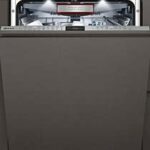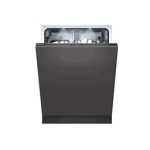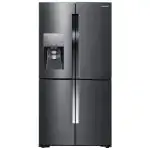
Refrigerator
User manual
1
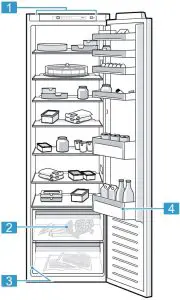
2

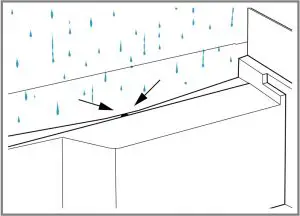
3 4
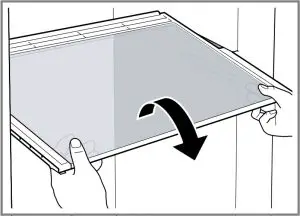
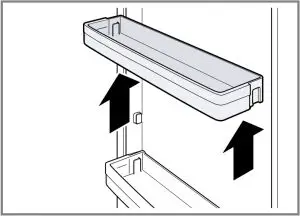
5 6
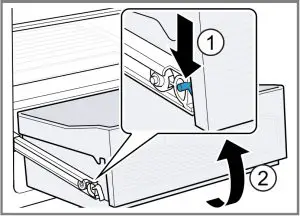
Please read the safety information to ensure that you use the appliance safely.
General information
You can find general information for this instruction manual here.
- Read this instruction manual carefully. Only this will ensure you use the appliance safely and efficiently.
- This manual is intended for the user of the appliance.
- Follow the safety instructions and warnings.
- Keep the instruction manual and the product information safe for future reference or for the next owner.
- Check the appliance after unpacking it. Do not connect the appliance if it has been damaged in transit.
Intended use
Read the information on intended use to ensure that you use the appliance correctly and safely.
This appliance is only intended to be fully fitted in a kitchen.
Only use this appliance:
- As specified in this instruction manual.
- For chilling food.
- In private households and in enclosed spaces in a domestic environment.
- Up to an altitude of max. 2000 m above sea level.
Restriction on user group
Avoid risks to children and vulnerable persons.
This appliance may be used by children aged 8 or over and by people who have reduced physical, sensory or mental abilities or inadequate experience and/or knowledge, provided that they are supervised or have been instructed on how to use the appliance safely and have understood the resulting dangers.
Children must not play with the appliance.
5
Cleaning and user maintenance must not be performed by children unless they are being supervised.
Keep children under the age of 8 years away from the appliance and power cable.
Children above the age of three years old and younger than eight years old may load and unload the the fridge-freezer.
Safe transport
Follow these safety instructions when transporting the appliance.
![]() WARNING-Risk of injury!
WARNING-Risk of injury!
The high weight of the appliance may result in injury when lifted.
- Do not lift the appliance on your own.
Safe installation
Follow these safety instructions when installing the appliance.
![]() WARNING-Risk of electric shock!
WARNING-Risk of electric shock!
- Improper installation is dangerous.
• Connect and operate the appliance only in accordance with the specifications on the rating plate.
• Connect the appliance to a power supply with alternating current only via a properly installed socket with earthing.
• The protective conductor system of the domestic electrical installation must be properly installed.
• Never equip the appliance with an external switching device, e.g. a timer or remote control.
• When the appliance is installed, the mains plug of the power cord must be freely accessible. If free access is not possible, an all-pole isolating switch must be installed in the permanent electrical installation according to the installation regulations.
• When installing the appliance, check that the power cable is not trapped or damaged. - If the insulation of the power cord is damaged, this is dangerous.
• Never let the power cord come into contact with heat sources.
• Never let the power cord come into contact with sharp points or edges.
• Never kink, crush or modify the power cord.
![]() WARNING-Risk of explosion!
WARNING-Risk of explosion!
If the appliance’s ventilation openings are sealed, a leak in the refrigeration circuit may result in a flammable mixture of gas and air.
- Keep ventilation openings, in the appliance enclosure or in the built-in structure, clear of obstruction.
![]() WARNING-Risk of fire!
WARNING-Risk of fire!
- It is dangerous to use an extended power cord and non-approved adapters.
• Do not use extension cables or multiple socket strips.
• If the power cord is too short, contact Customer Service.
• Only use adapters approved by the manufacturer. - Portable multiple socket strips or portable power supply units may overheat and cause a fire.
• Do not place portable multiple socket strips or power supply units on the back of the appliance.
Safe use
Follow these safety instructions when using the appliance.
![]() WARNING-Risk of electric shock!
WARNING-Risk of electric shock!
An ingress of moisture can cause an electric shock.
- Only use the appliance in enclosed spaces.
- Never expose the appliance to intense heat or humidity.
- Do not use steam- or high-pressure cleaners to clean the appliance.
7
![]() WARNING-Risk of suffocation!
WARNING-Risk of suffocation!
- Children may put packaging material over their heads or wrap themselves up in it and suffocate.
• Keep packaging material away from children.
• Do not let children play with packaging material. - Children may breathe in or swallow small parts, causing them to suffocate.
• Keep small parts away from children.
• Do not let children play with small parts.
![]() WARNING-Risk of explosion!
WARNING-Risk of explosion!
- Mechanical devices or other devices may damage the refrigeration circuit; flammable refrigerant may escape and explode.
• To accelerate the defrosting process, do not use any other mechanical devices or devices other than those recommended by the manufacturer. - Products which contain flammable propellants and explosive substances may explode, e.g. spray cans.
• Do not store products which contain flammable propellants (e.g. spray cans) or explosive substances in the appliance.
![]() WARNING-Risk of fire!
WARNING-Risk of fire!
Electrical devices within the appliance may cause a fire, e.g. heaters or electric ice makers.
• Do not operate electrical devices within the appliance.
![]() WARNING-Risk of injury!
WARNING-Risk of injury!
Injury to the eyes caused by escaping flammable refrigerant and hazardous gases.
• Do not damage the tubes of the refrigerant circuit or the insulation.
8
![]() CAUTION-Risk of harm to health!
CAUTION-Risk of harm to health!
- To prevent food from being contaminated, you must observe the following instructions.
• If the door is open for an extended period of time, this may lead to a considerable temperature increase in the compartments of the appliance.
• Regularly clean the surfaces that may come into contact with food and accessible drain systems.
• Store raw meat and fish in suitable containers in the refrigerator so that they do not touch or drip on other food.
• If the fridge/freezer is empty for an extended period of time, switch off the appliance, defrost it, clean it and leave the door open to prevent the formation of mould. - If acidic food comes into contact with aluminium in the appliance, aluminium foil ions may pass into the food.
• Do not consume soiled food.
Damaged appliance
Follow the safety instructions if your appliance is damaged.
![]() WARNING-Risk of electric shock!
WARNING-Risk of electric shock!
- If the appliance or the power cord is damaged, this is dangerous.
• Never operate a damaged appliance.
• Never operate an appliance with a cracked or fractured surface.
• Never pull on the power cord to unplug the appliance. Always unplug the appliance at the mains.
• If the appliance or the power cord is damaged, immediately unplug the power cord or switch off the fuse in the fuse box.
• “Call Customer Service.” → Page 22
• Repairs to the appliance should only be carried out by trained specialist staff. - Incorrect repairs are dangerous.
• Repairs to the appliance should only be carried out by trained specialist staff.
• Only use genuine spare parts when repairing the appliance.
9
• If the power cord of this appliance is damaged, it must be replaced by the manufacturer, the manufacturer’s Customer Service or a similarly qualified person in order to prevent any risk.
![]() WARNING -Risk of fire!
WARNING -Risk of fire!
![]()
If the tubes are damaged, flammable refrigerant and harmful gases may escape and ignite.
- Keep naked flames and ignition sources away from the appliance.
- Ventilate the room.
- “Switch off the appliance.” → Page 15
- Unplug the appliance from the mains or switch off the circuit breaker in the fuse box.
- “Call after-sales service.” → Page 22
10
Preventing material damage
Follow these instructions to prevent material damage to your appliance, accessories or other objects in your kitchen.
ATTENTION!
- Using the base, runners or appliance doors as a seat surface or climbing surface may damage the appliance.
• Do not stand or support yourself on the base, runners or doors. - Contamination with oil or fat may cause plastic parts and door seals to become porous.
• Keep plastic parts and door seals free of oil and grease. - Metal or metal-style parts in the appliance may contain aluminium. Aluminium reacts when it comes into contact with acidic foods.
• Do not store unpackaged food in the appliance.
Environmental protection and saving energy
Help protect the environment by using your appliance in a way that conserves resources and by disposing of reusable materials properly.
Disposing of packaging
The packaging materials are environmentally compatible and can be recycled.
- Sort the individual components by type and dispose of them separately.
Information about current disposal methods are available from your specialist dealer or local authority.
Saving energy
If you follow these instructions, your appliance will use less power.
Selecting the installation location
Follow these instructions when installing your appliance.
- Keep the appliance out of direct sunlight.
- Install the appliance as far away as possible from heating elements, cookers and other heat sources:
– Maintain a 30 mm clearance to electric or gas cookers.
– Maintain a 30 cm clearance to oil or solid-fuel cookers.
+ The appliance needs to cool less frequently at low ambient temperatures. - Use a niche depth of 560 mm.
- Do not cover or block ventilation openings.
+ The air on the back wall of the appliance can escape more easily and the appliance does not warm up so intensely.
The appliance must cool less frequently.
Saving energy during use
Follow these instructions when using your appliance.
Note: The arrangement of the fittings does not affect the energy consumption of the appliance.
11
- Do not cover or block ventilation openings.
+ The air on the back wall of the appliance can escape more easily and the appliance does not warm up so intensely. - Open the appliance door only briefly.
- Transport purchased food in a cool bag and place in the appliance quickly.
- Allow warm food and drinks to cool down before placing them in the appliance.
- Thaw frozen food in the refrigerator compartment to utilise the low temperature of the food.
+ The air in the appliance does not warm up so intensely. The appliance must cool less frequently. - Always leave some space between the food and to the back panel.
- Pack the food airtight.
+ The air can circulate and the air humidity remains constant.
Installation and connection
You can find out where and how best to install your appliance here. You will also learn how to connect your appliance to the power supply.
Scope of delivery
After unpacking all parts, check for any transport damage and for completeness of delivery. If you have any complaints, contact your dealer or our “after-sales service” → Page 22.
The delivery consists of the following:
- Built-in appliance
- Equipment and accessories¹
- Installation material
- Installation instructions
- User manual
- Customer service booklet
- Warranty enclosure²
- Energy label
- Information on energy consumption and noises
Installing and connecting the appliance
Requirement: “The scope of delivery of the appliance is checked.”
→ Page 12
1. “Observe the criteria for the appliance’s installation location.”
→ Page 13
2. Install the appliance according to the enclosed installation instructions.
3. “Prepare the appliance for first use.” → Page 13
¹ Depending on the appliance specifications
² Not in all countries
12
Installation and connection en
4. “Electrically connect the appliance.” → Page 13
Criteria for the installation location
Follow these instructions when installing your appliance.
![]() WARNING
WARNING
Risk of explosion!
If the appliance is in a space that is too small, a leak in the refrigeration circuit may result in a flammable mixture of gas and air.
- Only install the appliance in a space with a volume of at least 1 m³ per 8 g refrigerant. The volume of refrigerant is indicated on the rating plate. → Fig. 1/
The weight of the appliance ex works may be up to 70 kg depending on the model.
The subfloor must be of sufficient stability to bear the weight of the appliance.
Permitted room temperature
The permitted room temperature depends on the appliance’s climate class. The climate class can be found on the rating plate. → Fig. 1/
Climate class Permitted room temperature
SN 10°C to 32°C
N 16°C to 32°C
ST 16°C to 38°C
T 16°C to 43°C
The appliance is fully functional within the permitted room temperature.
If an appliance with climate class SN is operated at colder room temperatures, the appliance will not be damaged up to a room temperature of 5°C.
Niche dimensions
Observe the niche dimensions if you install your appliance in the niche. If this is not the case, problems may occur when installing the appliance.
Niche depth
Install the appliance in the recommended niche depth of 560 mm. If the niche depth is smaller, the energy consumption increases slightly. The niche depth must be a minimum 550 mm.
Niche width
An inside niche width of at least 560 mm is required for the appliance.
Preparing the appliance for the first time
- Remove the informative material.
- Remove the protective foil and transit bolts, e.g. remove the adhesive strips and carton.
- “Clean the appliance for the first time.” → Page 17
Connecting the appliance to the electricity supply
- Insert the mains plug of the appliance’s power cable in a socket nearby.
The connection data of the appliance can be found on the rating plate. → Fig. 1/ - Check the mains plug is inserted properly.
 The appliance is now ready for use.
The appliance is now ready for use.
13
Familiarising yourself with your appliance
Familiarise yourself with the parts of your appliance.
Appliance
You can find an overview of the parts of your appliance here.
Note: Deviations between your appliance and the diagrams may differ with regard to their features and size.
→ Fig. 1
Controls
“Fruit and vegetable container” → Page 14
Rating plate
Door storage compartment for large bottles
Controls
The controls are used to configure all functions of your appliance and to obtain information about the operating status.
→ Fig. 2
> sets the temperature of the refrigerator compartment.
Super lights up when Super cooling is switched on.
Displays the set temperature for the refrigerator compartment in °C.
 switches the appliance on or off.
switches the appliance on or off.
Features
Here Features you can see an overview of the features of your appliance and their use.
The features of your appliance depend on the model.
Shelf
To vary the shelf as required, you can remove the shelf and re-insert it elsewhere.
→ “Removing the shelf”, Page 18
Fruit and vegetable container
Store fresh fruit and vegetables in the fruit and vegetable container.
Condensation may form in the fruit and vegetable container depending on the food and quantity stored. Remove the condensation with a dry cloth.
To ensure that the quality and aroma are retained, store fruit and vegetables that are sensitive to cold outside of the appliance at temperatures of approx. 8°C to 12°C.
Fruit that is sensitive to cold
- Pineapples
- Bananas
- Mangoes
- Papayas
- Citrus fruits
Vegetables that are sensitive to cold
- Aubergines
- Gherkins
- Courgettes
- Peppers
- Tomatoes
- Potatoes
14
Door racks
To adjust the door racks as required, you can remove the door rack and re-insert elsewhere.
→ “Removing door racks”, Page 18
Accessories
Only use original accessories. These have been made especially for your appliance. Here you can find an overview of your appliance’s accessories and how to use them.
The accessories for your appliance depend on the model.
Egg tray
Store eggs safely on the egg tray.
Basic operation
You can find out everything you need to know about operating your appliance here.
Switching on the appliance
- Press
 .
.
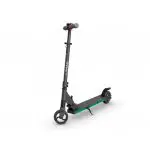 The appliance begins to cool.
The appliance begins to cool. - “Set the required temperature.”
→ Page 15
Operating tips
- Once you have switched on the appliance, the set temperature is only reached after several hours. Do not put any food in the appliance until the temperature has been reached.
- When you close the door, a vacuum may be created. The door is then difficult to open again. Wait a moment until the vacuum is offset.
Switching off the appliance
![]() Press
Press  .
.
![]() The appliance stops cooling.
The appliance stops cooling.
Setting the temperature
After you have switched on the appliance, you can set the temperature.
Setting the refrigerator compartment temperature
![]() Press > repeatedly until the temperature display shows the required temperature.
Press > repeatedly until the temperature display shows the required temperature.
The recommended temperature in the refrigerator compartment is 4°C.
→ ““OK” sticker”, Page 16
Additional functions
Find out which additional functions which can be used for your appliance.
Super cooling
Super cooling cools the refrigerator compartment to make it as cold as possible. This cools food and drinks quickly through.
Switch on Super cooling before placing large quantities of food in the freezer compartment.
Note: When Super cooling is switched on, increased noise may occur.
Switching on Super cooling
![]() Press > repeatedly until Super lights up.
Press > repeatedly until Super lights up.
Note: After approx. 15 hours, the appliance switches to normal operation.
15
Switching off Super cooling
![]() Press >.
Press >.
Refrigerator compartment
You can keep meat, sausage, fish, dairy products, eggs, prepared meals and pastries in the refrigerator compartment.
You can set the temperature in the refrigerator compartment from 2°C to 8°C.
The recommended temperature in the refrigerator compartment is 4°C.
→ ““OK” sticker”, Page 16
The refrigerator compartment can also be used to store highly perishable foods in the short to medium term. The lower the selected temperature, the longer the food remains fresh.
Tips for storing food in the refrigerator compartment
Follow the tips if you store food in your refrigerator compartment.
- To ensure that the freshness and quality of the food is retained for longer, only store fresh and unspoiled food.
- In the case of ready-made products and bottled goods, do not exceed the best-before date or use-by date specified by the manufacturer.
- To retain aroma, colour and freshness or to prevent taste transfer and discolouration of the plastic parts, store food well wrapped or covered.
- Leave warm food and beverages to cool down before placing them in the refrigerator compartment.
Chill zones in the refrigerator compartment
The air circulation in the refrigerator compartment creates different chill zones.
Coldest zone
The coldest zone is between the arrow stamped on the side and the shelf underneath.
Tip: Store perishable food (e.g. fish, sausage, meat) in the coldest zone.
Warmest zone
The warmest zone is at the very top of the door.
Tip: Store food that does not spoil easily in the warmest zone, e.g. hard cheese and butter. Cheese can then continue to release its aroma and the butter will still be easy to spread.
“OK” sticker
The “OK” sticker lets you check whether the refrigerator compartment reaches the safe temperature ranges of +4°C or colder recommended for food.
The “OK” sticker is not included with all models.
If the sticker does not indicate “OK”, gradually reduce the temperature.
→ “Setting the refrigerator compartment temperature”, Page 15
Once the appliance is switched on, it may take up to 12 hours until the set temperature is reached.

Correct setting
16
Defrosting
Observe the information when you want to defrost your appliance.
Defrosting in the refrigerator compartment
When the appliance is operating, condensation droplets or frost form on the rear panel of the refrigerator compartment due to functional reasons. The back panel in the refrigerator compartment defrosts automatically.
Condensation runs through the condensation channel into the drainage hole to the evaporation pan and does not have to be wiped away.
To ensure that the condensation can drain and odours do not form, observe the following information:
→ “Cleaning the condensation channel and drainage hole”, Page 18.
Cleaning and servicing
To keep your appliance working efficiently for a long time, it is important to clean and maintain it carefully. Customer Service must clean inaccessible points. Cleaning by customer service can give rise to costs.
Preparing the appliance for cleaning
Find out how to prepare your appliance for cleaning.
- “Switch off the appliance.”
→ Page 15 - Disconnect the appliance from the power supply.
Unplug the appliance from the mains or switch off the circuit breaker in the fuse box. - Take out all of the food and store it in a cool place.
Place ice packs (if available) onto the food. - If there is a layer of hoarfrost, allow this to defrost.
- “Remove all fittings from the appliance.” → Page 18
Cleaning the appliance
Clean the appliance as specified to ensure that it is not damaged by incorrect cleaning or unsuitable cleaning products.
![]() WARNING
WARNING
Risk of electric shock!
- An ingress of moisture can cause an electric shock.
• Do not use steam- or high-pressure cleaners to clean the appliance. - Liquid in the lighting can be dangerous.
• The rinsing water must not run into the light.
ATTENTION!
- Unsuitable cleaning products may damage the surfaces of the appliance.
• Do not use hard scouring pads or cleaning sponges.
• Do not use harsh or abrasive detergents.
• Do not use cleaning products with a high alcohol content. - If you clean fittings and accessories in the dishwasher, this may cause them to become deformed or discolour.
• Never clean fittings and accessory in the dishwasher.
- “Prepare the appliance for cleaning.” → Page 17
- Clean the appliance, the fittings and the door seals clean with a dish cloth, lukewarm water and a little pH-neutral washing-up liquid.
- Dry thoroughly with a soft, dry cloth.
- Insert the fittings.
- Electrically connect the appliance.
- “Switch on the appliance.”
→ Page 15 - Putting the food into the appliance.
Cleaning the condensation channel and drainage hole
Regularly clean the condensation channel and drainage hole to ensure that the condensation can drain.
- Carefully clean the condensation channel and the drainage hole, e.g. using a moistened cotton bud.
→ Fig. 3
Removing the fittings
If you want to clean the fittings thoroughly, remove these from your appliance.
Removing the shelf
- Pull out and remove the shelf.
→ Fig. 4
Removing door racks
- Lift the door rack upwards and remove it.
→ Fig. 5
Removing the fruit and vegetable container
- Pull out the fruit and vegetable container as far as it will go.
- Press the latch on the pull-out rail downwards 1 and remove the fruit and vegetable container 2.
→ Fig. 6
18
Troubleshooting
You can rectify minor faults on your appliance yourself. Read the troubleshooting information before contacting after-sales service. This will avoid unnecessary costs.
![]() WARNING
WARNING
Risk of electric shock!
Incorrect repairs are dangerous.
- Repairs to the appliance should only be carried out by trained specialist staff.
- Only use genuine spare parts when repairing the appliance.
- If the power cord of this appliance is damaged, it must be replaced by the manufacturer, the manufacturer’s Customer Service or a similarly qualified person in order to prevent any risk.
Malfunctions
| Fault | Cause | troubleshooting |
| The appliance is not working.
No displays light up. |
The mains plug has not been inserted properly. | |
| Fuse has been tripped. | ||
| The power has failed. | 1. Check whether the power is on. 2. Place ice packs (if available) on the top shelf. |
|
| The appliance is not cooling, the displays and lighting light up. | Showroom mode is switched on. | → Page 21
|
| The LED lighting does not work.
Do not remove the lamp cover. |
Different causes are possible. | |
| The refrigeration unit is switching on more frequently and for longer. | The appliance door was opened frequently. | |
| The ventilation openings are covered up. | ||
| The base of the refrigerator compartment is wet. | The condensation channel or drainage hole are blocked. |
19
Temperature problem
| Fault | Cause | troubleshooting |
| The temperature differs greatly from the setting. | Different causes are possible. | 1. “Switch off the appliance.”
→ Page 15 2. “Switch the appliance back on after five minutes.” → Page 15 ‒ If the temperature is too warm, check the temperature again after a couple of hours. ‒ If the temperature is too cold, check the temperature again on the following day. |
Noise
| Fault | Cause | troubleshooting |
| Appliance has a humming sound. | Not a fault. A motor is running, e.g. refrigerating unit, fan. | No action required. |
| The appliance bubbles, buzzes or gargles. | Not a fault. Refrigerant flows through the pipes. | No action required. |
| The appliance clicks. | Not a fault. Motor, switches or solenoid valves are switching on or off. | No action required. |
| The appliance makes noises. | Fittings wobble or stick. | |
| Bottles or containers are touching. |
Odours
| Fault | Cause | troubleshooting |
| The appliance has an unpleasant smell. | Different causes are possible. | 1. “Prepare the appliance for cleaning.” → Page 17
2. “Clean the appliance.” → Page 17 3. Clean all food packaging. 4. To prevent odours from forming, store strong smelling food in airtight containers. 5. After 24 hours, check whether odours are still forming. |
20
Conducting an appliance self-test
- “Switch off the appliance.”
→ Page 15 - “Switch the appliance back on after approx. five minutes.”
→ Page 15 - Within 10 seconds of switching on, press and hold for three to five seconds until 2°C lights up in the temperature display.
 The appliance self-test starts when the temperature displays light up in succession.
The appliance self-test starts when the temperature displays light up in succession.
 If, at the end of the appliance self-test, the temperature display shows the set temperature, your appliance is OK. The appliance switches to normal operation.
If, at the end of the appliance self-test, the temperature display shows the set temperature, your appliance is OK. The appliance switches to normal operation.
 If, at the end of the appliance self-test, flashes for 10 seconds, inform the after-sales service.
If, at the end of the appliance self-test, flashes for 10 seconds, inform the after-sales service.
Storage and disposal
You can find out here how to prepare your appliance for storage. You will also find out how to dispose of old appliances.
Switching off the appliance
- “Switch off the appliance.”
→ Page 15 - Disconnect the appliance from the power supply.
Unplug the appliance from the mains or switch off the circuit breaker in the fuse box. - “Defrost the appliance.” → Page 17
- “Clean the appliance.” → Page 17
- To ensure the ventilation inside the appliance, leave the appliance open.
Disposing of old appliance
Valuable raw materials can be reused by recycling.
![]() WARNING
WARNING
Risk of harm to health!
Children can lock themselves in the appliance, thereby putting their lives at risk.
- Leave shelves and containers inside the appliance to prevent children from climbing in.
- Keep children away from the redundant appliance.
![]() WARNING
WARNING
Risk of fire!
If the tubes are damaged, flammable refrigerant and harmful gases may escape and ignite.
- Do not damage the tubes of the refrigerant circuit or the insulation.
- Unplug the appliance from the mains.
- Cut through the power cord.
- Dispose of the appliance in an environmentally friendly manner.

This appliance is labelled in accordance with European Directive 2012/19/EU concerning used electrical and electronic appliances (waste electrical and electronic equipment – WEEE). The guideline determines the framework for the return and recycling of used appliances as applicable throughout the EU.
21
Customer Service
If you have any queries, are unable to rectify faults on the appliance yourself or if your appliance needs to be repaired, contact Customer Service. You can solve many problems yourself by consulting the information on troubleshooting in these instructions or on our website. If this is not the case, contact our after-sales service. We will always find an appropriate solution and try to avoid unnecessary visits being made by a Customer Service technician.
With any warranty claims, we will make sure that your appliance is repaired by trained after-sales technicians using genuine spare parts, including after the manufacturer’s warranty has expired.
For safety reasons repairs to the appliance should only be carried out by trained specialist staff. The warranty claim becomes void if repairs or interventions have been carried out by persons not authorised by us for that purpose or if our appliances have been fitted with spare, supplementary or accessory parts that were not genuine parts and then resulted in a defect.
Function-relevant genuine spare parts according to the corresponding Eco-design Order can be obtained from Customer Service for a period of at least 10 years from the date on which your appliance was placed on the market within the European Economic Area.
Note: Under the terms of the manufacturer’s warranty applicable to the location, the use of Customer Service is free of charge. The minimum duration of the warranty (manufacturer’s warranty for private consumers) in the European Economic Area is 2 years according to the terms of warranty applicable to the location. The terms of warranty do not affect other rights or claims held by yourself under local legislation.
Detailed information on the warranty period and terms of warranty in your country is available from our aftersales service, your retailer or on our website.
If you contact Customer Service, you will require the product number (E-Nr.) and the production number (FD) of your appliance.
The contact details for Customer Service can be found in the enclosed Customer Service directory or on our website.
Product number (E-Nr.) and production number (FD)
You can find the product number (E-Nr.) and the production number (FD) on the appliance’s rating plate.
→ Fig. 1/
Make a note of your appliance’s details and the Customer Service telephone number to find them again quickly.
Technical data
Refrigerant, cubic capacity and further technical specifications can be found on the rating plate.
→ Fig. 1/
More information about your model can be found online at https://energylabel.bsh-group.com¹. This web address is linked to the official EU EPREL product database. At the time
¹ Only applies to countries in the European Economic Area
22
of printing its web address had not yet been published. Please then follow the instructions on searching for models. The model identifier is made up of the characters before the slash in the product number (E-Nr.) on the rating plate. Alternatively you can also find the model identifier in the first line of the EU energy label.
23


REGISTER YOUR PRODUCT ONLINE NEFF-HOME.COM
Constructa-Neff Vertriebs-GmbH
Carl-Wery-Straße 34
81739 München
GERMANY

